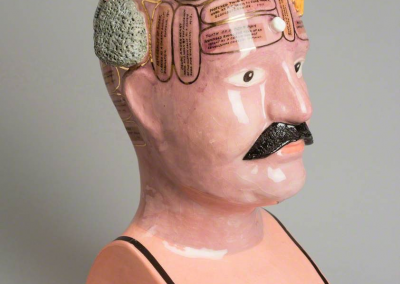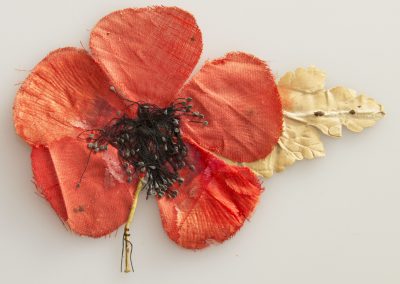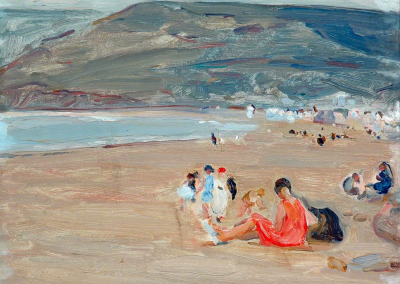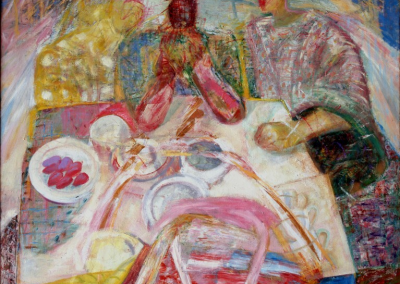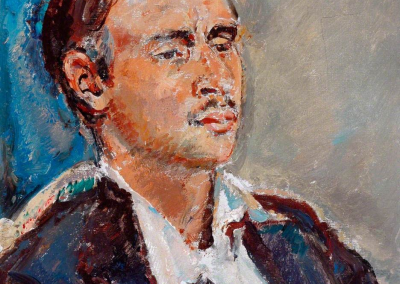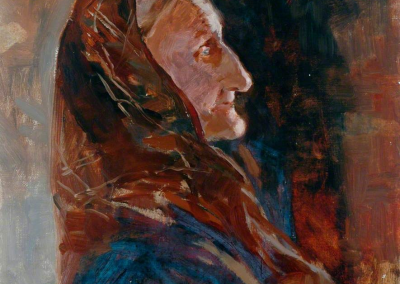‘Miss Terry’ by Eileen Agar
Mercer Art Gallery, Harrogate
This unusual surrealist portrait was painted in 1980 by Eileen Agar (1899 – 1991). Born in Buenos Aires, Agar studied art at the Slade School of Fine Art, developing a unique style. She became an important figure in the Surrealist movement, known for her imaginative and dreamlike artworks. Her innovative use of everyday objects and creative techniques made her a key contributor to modern art. In ‘Miss Terry’, Agar has used striking colours and bold shapes and symbols to represent a female figure.
Agar was also known for creating assemblage sculptures, made by combining different objects together to form something new. Perhaps you can see the influence of the assemblage artform on the way she has combined different shapes and patterns to piece together ‘Miss Terry’?
Exploring Agar’s subject matter
Within theatrical circles, some people will recognise the name of ‘Miss Terry’ as belonging to Dame Ellen Terry, a famous Shakespearean actress during the late 19th and early 20th centuries. Could that ‘Miss Terry’ have been the inspiration behind Agar’s artwork?
A particularly famous painting of Dame Ellen Terry as Lady MacBeth was created by artist John Singer Sargent in 1889.
Could Agar have been responding to that painting? What similarities can you spot? Or is the artwork’s title just a play on the word ‘mystery’?
What emotions do you feel when you look at the painting?
Why do you think Agar has painted it?
How many different shapes can you spot in the painting?
Do you agree that it is a portrait of Dame Ellen Terry, or do you think it is something different?
Surrealist artists often combine ideas in surprising ways in order to reveal a different kind of truth. What do you find surprising about this painting? What do you think Agar might have been saying about the subject matter?
Look closely at the painting. What other details can you spot?
Do you like it overall? Would you want it on your wall?
Vocabulary
Surrealist art: this style of art seeks to express the workings of the subconscious mind, creating dreamlike, fantastical, and sometimes bizarre imagery. Beginning in the 1920s, it often features unexpected juxtapositions or illogical scenes, and includes elements of surprise with the aim of unlocking the imagination in the search for deeper truths
Assemblage art: this artwork involves creating three-dimensional works by combining various found objects and materials

In the Classroom
Hold a Debate
Introduce the debate motion: This artwork has clearly been created in response to a painting by John Singer Sargent.
Does anyone agree? Does anyone disagree? Listen to a range of ideas before holding a class vote.
You can read tips for creating formal debates. Debates don’t necessarily need time to be prepared – sometimes the discussion can take place as a form of thinking aloud and students can be free to change their opinions during the course of conversation.

Hands on History
The Mercer Art Gallery in Harrogate has a changing programme of exhibitions which are free to access. Find out more on their website.
Find more art by female artists



